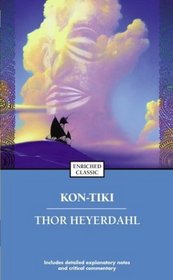Helpful Score: 2
Read this book over 40 years ago, and found it so inspiring that I never forgot it. I would highly recommend it for any age from adolescence on. An amazing account of what the human spirit is capable of.
Helpful Score: 1
In 1947, Thor Heyerdahl along with five other men journeyed by raft across the Pacific Ocean from Peru to the Polynesian Islands. This historic voyage is documented in Heyerdahl's book Kon-Tiki. The raft was named Kon-Tiki after an Inca god andHeyerdahl believed that people from South America could have reached Polynesia during pre-Columbian times. His aim in mounting the Kon-Tiki expedition was to show, by using only the materials and technologies available to those people at the time, that there were no technical reasons to prevent them from having done so. Although the expedition carried some modern equipment, such as a radio, watches, charts, sextant, and metal knives, Heyerdahl argued they were incidental to the purpose of proving that the raft itself could make the journey.
This was really a great adventure story. I have always admired explorers and adventurers who set out into the unknown putting themselves in peril. The raft did make it all the way to Raroia, a large atoll in the Pacific. Along the way, the men on the raft were able to survive some unlikely adventures and were able to use the spoils of the sea to sustain themselves. Every morning the crew gathered up flying fish which they used as food and also as bait for other fish including dolphin (the fish not the mammal), shark, tuna, bonito, and others. I had never heard of the dolphin fish and at first thought they were eating Flipper's kin. However, I looked it up on google and the dolphin fish is also called Mahi-mahi which I am familiar with. I know that it is a very good seafood. They also encountered a whale shark, the largest fish known, large squid, eels, and an ugly fish called a snake mackerel (Latin name Gempylus) that jumped on board one night into one of the crew's sleeping bag.
The book also detailed Heyerdahl's theory about Polynesia being populated from South America. He describes many of the ruins in South America and how they compare to what is in Polynesia. This includes the stone monoliths on Easter Island and other statues as well as the pyramids found in both places. A rather convincing argument. (Heyerdahl also later traveled to Easter Island and wrote another memoir about his discoveries there called Aku-Aku. I read this one back in the 70s and I probably should give it a reread.)
Overall, a really interesting and educational read. Although the Kon-Tiki raft did crash on a reef, it was salvaged and now resides in a museum in Norway.
This was really a great adventure story. I have always admired explorers and adventurers who set out into the unknown putting themselves in peril. The raft did make it all the way to Raroia, a large atoll in the Pacific. Along the way, the men on the raft were able to survive some unlikely adventures and were able to use the spoils of the sea to sustain themselves. Every morning the crew gathered up flying fish which they used as food and also as bait for other fish including dolphin (the fish not the mammal), shark, tuna, bonito, and others. I had never heard of the dolphin fish and at first thought they were eating Flipper's kin. However, I looked it up on google and the dolphin fish is also called Mahi-mahi which I am familiar with. I know that it is a very good seafood. They also encountered a whale shark, the largest fish known, large squid, eels, and an ugly fish called a snake mackerel (Latin name Gempylus) that jumped on board one night into one of the crew's sleeping bag.
The book also detailed Heyerdahl's theory about Polynesia being populated from South America. He describes many of the ruins in South America and how they compare to what is in Polynesia. This includes the stone monoliths on Easter Island and other statues as well as the pyramids found in both places. A rather convincing argument. (Heyerdahl also later traveled to Easter Island and wrote another memoir about his discoveries there called Aku-Aku. I read this one back in the 70s and I probably should give it a reread.)
Overall, a really interesting and educational read. Although the Kon-Tiki raft did crash on a reef, it was salvaged and now resides in a museum in Norway.




